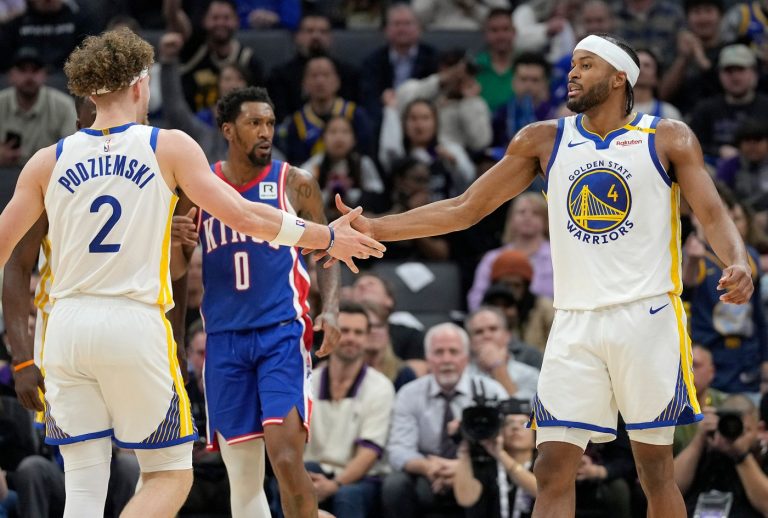The Hotline mailbag publishes weekly. Send questions to wilnerhotline@bayareanewsgroup.com and include ‘mailbag’ in the subject line. Or hit me on Twitter/X: @WilnerHotline
Please note: Some questions have been edited for clarity and brevity.
Why does the rest of college football sit back and let the Big Ten and SEC make decisions that affect everyone? They make a lot of money, but they aren’t sharing it. Why don’t the 100 other schools separate? I think their tournament would be just as popular. — @brycetacoma
In the wake of the historic meeting of SEC and Big Ten administrators on Thursday, this topic offers a timely start to the Hotline mailbag.
The sentiment is understandable, and shared by many. But a separation agreement isn’t plausible — at least for the “100 other schools.”
First, the “rest of college football” doesn’t have a choice in the decision-making process. The Big Ten and SEC have the vast majority of premium football brands — the brands that drive the cash flow and thus dictate the power.
The entire system is broken, and has been.
College athletics is a multi-billion dollar annual business, except it’s unlike any other business in that each school is required by federal law to support more than a dozen money-losing subsidiaries (i.e., the Olympic sports).
We are not suggesting that Title IX has been anything but transformative over its 52-year history, only that the post-modern era of college sports is facing economic pressures that did not exist in 1972.
Those economic pressures (NIL, revenue-sharing, market-based expenses) have forced the schools to seek every last dime available, even if their pursuit means joining conferences on the other side of the country.
Who controls the cash the schools are craving? ESPN and Fox, of course.
And how do ESPN and Fox allocate their dollars? To the football schools that drive ratings.
To the biggest media brands.
The blue bloods.
With a few exceptions (Notre Dame, Clemson, Florida State and perhaps Miami), those brands are located entirely within the Big Ten and SEC.
In our view, and in no particular order, the breakdown is as follows:
— Big Ten: Ohio State, Michigan, Penn State, USC, Nebraska, Oregon and Washington.
— SEC: Alabama, Auburn, Georgia, Texas, Oklahoma, Tennessee, Texas A&M, LSU and Florida.
Put another way: The most valuable companies — err, conferences — lie at the center of the college sports industry, just as they do in every other industry.
In theory, the other major college football schools could break away. But they would command a relative pittance on the market, and the viewing audience would be limited.
Also, the Big 12 and ACC have no desire to separate. They are clinging to the Big Ten and SEC with every ounce of strength and effort.
Why? Because they need the cash that comes with competing against the Big Two in the regular season and the College Football Playoff.
If there is a cleaving of the Power Four, it will come as the result of the Big Ten and SEC proactively breaking away, not the ACC and Big 12 willingly disassociating themselves.
As for the Group of Five schools, well, they remain at the mercy of the Power Four conferences. Which are at the mercy of the Big Two. Which, in our view, are effectively controlled by a select group of five: Ohio State, Michigan, Alabama, Georgia and Texas.
What a time to be alive.
Once college football devolves into a super league, will scheduling be controlled by the commissioner (hello, Nick Saban) or by the athletic directors? — Jon J
The more cynical view is that when the super league forms — and we believe it will be in the early 2030s, because of the existing TV contracts — the scheduling will ultimately be dictated by ESPN, Fox or whichever media company is paying billions for the broadcast rights.
Within the broad framework approved by the media partners, specifics of the regular-season schedule would fall to whatever central entity operates the league.
There is much talk about the need for a college football commissioner (or czar) to solve problems and ensure equity.
But the Big Ten and SEC have no interest in relinquishing power to a singular individual because that would undermine their authority.
The current system works fabulously for them. They set policy, hoard the cash and govern the postseason format.
Why should they permit any structural change in the sport’s leadership? In the void that exists, they run the show.
Were Boise State, San Diego State, Fresno State, and Colorado State instrumental in killing the Pac-12’s schedule agreement with the Mountain West for 2025 so they could make the move to the Pac-12? — @Wazzucoug1996
I have not received a morsel of credible information suggesting there was a deep-States plot — see what I did there? — within the Mountain West to kneecap the conference.
Yes, commissioner Gloria Nevarez took a hardline stance on extending the scheduling agreement, and that tactic left the Pac-12 deeply frustrated. But her approach likely reflected the consensus sentiment within the Mountain West’s boardroom.
Also, the unraveling of the scheduling agreement with the Pac-12 and the departure of the four (initial) schools to the Pac-12 were not intertwined. They would have bolted even if the agreement had been approved for 2025. (At least, that’s our read on the situation.)
But generally speaking, the Mountain West fell victim to the same errant strategy we have seen time and time again, including within the former Pac-12:
Strategic positions that do not prioritize the best interests of the biggest brands.
What’s preventing Memphis and the Pac-12 from coming together? Memphis seems to check all the boxes, and now with Gonzaga, the Tigers would add another historically good basketball program. Plus they bring the Central Time Zone. — @DonaldFarmer65
Nothing is preventing it, unless the Tigers have signed a binding agreement with the American Athletic Conference. Is that the case? Athletic director Ed Scott sure seemed to suggest Memphis is available for the right price.
Notably, multiple sources have told the Hotline that the Pac-12 never made a final offer to Memphis, Tulane and South Florida and was surprised by their immediate, public rejection before negotiations truly got serious.
In that regard, we certainly wonder if there’s room for a second round of conversation (assuming Memphis is not legally bound to the AAC).
That said, we are skeptical about the impact of the ACC schools on the Pac-12’s bottom line.
Yes, the Central and Eastern time zones would open broadcast windows, but none of the schools are located in A-level markets or drive big ratings.
For that reason, it’s unclear just how much additional value could be generated for the eight schools that will form the heart of the conference in 2026.
Paying for themselves wouldn’t be enough. They would have to increase the revenue splits for the other members.
How much of the Pac-12’s war chest of approximately $250 million remains after adding the five members? How much might be available to make another run at Memphis and Tulane? — Yoni
There is no way to answer that question accurately because of the legal complaint filed by the Pac-12 against the Mountain West over the “poaching penalty” written into the scheduling agreement for 2024.
The Pac-12 contends the penalty, which amounts to $55 million for the five schools switching conferences, violates antitrust law.
If the Pac-12 wins, or if the two sides reach a settlement, that expense could be trimmed by millions — and perhaps by tens of millions.
What we do know is the Pac-12 withheld $65 million from the 10 departed schools and earmarked that stash of cash for the rebuilding plan. So in theory, there will be at least $10 million remaining.
The conference’s coffers also have $100 million from the Rose Bowl and another $100 million (roughly) from the NCAA Tournament and the College Football Playoff.
But most of that “war chest” will be used to fund athletic operations in Corvallis and Pullman during this multi-year transition phase.
Is there a chance the Pac-12 will sign separate media contracts for football and basketball? Or is it going to be a package deal? — @CelestialMosh
Do not dismiss any option when it comes to the media rights negotiations.
Once the Pac-12 hooked Gonzaga, the focus turned to taking the football and basketball inventory to the market, a process that could take months.
The outcome will determine the next membership move, whether it’s adding basketball schools to create enough inventory to split the rights or focusing on the best football option or the largest market.
At this point, it’s all guesswork. But be prepared for anything, including football games in unusual broadcast windows.
I am happy that we Beavers now have some stability, but isn’t this pretty much just the Mountain West splitting into two divisions? — @dumbfanatic
It is akin to the Mountain West splitting into two divisions … then cutting loose the lower division.
Related Articles
CFB recruiting: Oregon’s blue-chip targets to attend Ohio State game
CFB Week 7 picks ATS: Oregon beats Ohio State for Big Ten supremacy
Comcast and Fox reach agreement, ending Big Ten Network blackout on West Coast
Holy Score: Oddsmaker’s early line has Utah favored over Brigham Young (with or without QB Cam Rising)
Did ACC officials miss a targeting call in Cal’s loss to Miami? Our analysis of the controversial play
The reconstituted Pac-12 is Washington State, Oregon State and the top tier of the Mountain West — the schools that carry the most media and competitive value.
When you add Gonzaga, the basketball product is even better.
In fact, the Hotline would argue the reconstituted Pac-12 could become a better basketball conference than the former Pac-12, with Gonzaga and San Diego State as the tentpoles.
On the hardwood, the majority of former Pac-12 basketball programs were skull-crushingly mediocre.
How much is the Pac-12 banking on the ACC breaking up and Cal and Stanford being able to return to the fold? — @MarcSheehan006
The Pac-12 is not-so-quietly rooting for the ACC to fracture. Oregon State athletic director Scott Barnes said as much on an episode of ‘Canzano and Wilner: The Podcast’ last month.
“Chaos is our friend because, ultimately,” Barnes said, “it can give more optionality than what we’re thinking about.”
Every strategic move by the Pac-12 has been made with the idea of providing a landing spot for Stanford and Cal if the ACC crumbles.
(And you can bet the Pac-12 media rights agreement that begins in 2026 will have options for adding the Cardinal and Bears.)
But remember: The Bay Area schools are under contract with the ACC until 2036, albeit with a revenue agreement that places them at a competitive disadvantage.
They could only become available if the ACC fractures to the point that the grant-of-rights agreement becomes null and void.
And even then, Stanford and Cal surely will seek membership in the Big Ten before they agree to join the rebuilt Pac-12.
What sports does a school need to count as a “full sport” member of a conference? — @crashlit
The simplest way to view the membership issue for the Pac-12 and Mountain West is this:
To be recognized by the NCAA, they must have at least eight schools that compete in the conference in both football and basketball.
As of now, Hawaii is not a full member of the Mountain West because it only competes in football — the other sports are in the Big West — and Gonzaga won’t be a full member of the Pac-12 because it doesn’t sponsor football.
However, like so much else about the NCAA, conference membership standards could provide fluid. At some point in the coming months or years, the current requirement (eight full members) might be abandoned.
*** Send suggestions, comments and tips (confidentiality guaranteed) to wilnerhotline@bayareanewsgroup.com or call 408-920-5716
*** Follow me on Twitter/X: @WilnerHotline












